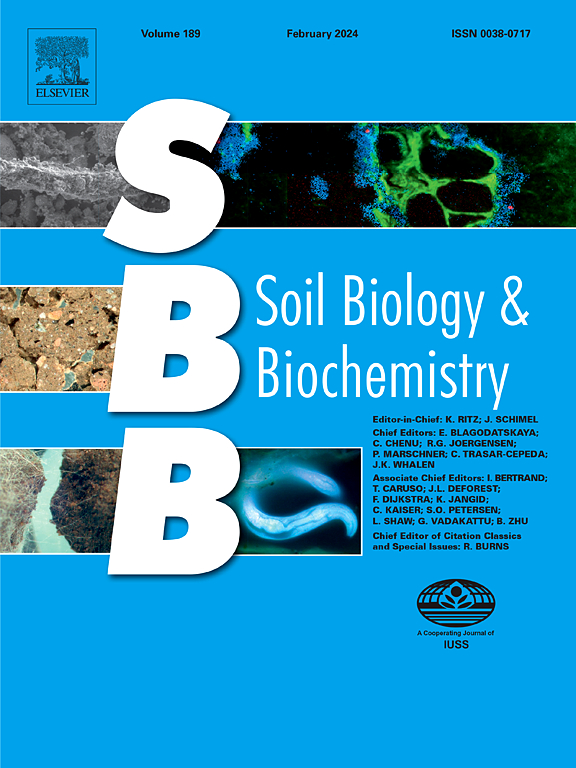Microbial carbon use efficiency of mineral-associated organic matter is related to its desorbability
IF 9.8
1区 农林科学
Q1 SOIL SCIENCE
引用次数: 0
Abstract
Interactions between organic substances, minerals, and microorganisms are crucial for organic carbon (OC) stabilization in soil. We hypothesized that thresholds of sorption strength (described by the sorption coefficient of the Freundlich isotherms) and desorbability (i.e., the ratio of the amount desorbed to the amount sorbed) of organic monomers control the extent of their microbial processing.
Freundlich sorption isotherms and desorbability of uniformly 14C-labeled glucose, acetylglucosamine, phenylalanine, salicylic acid, and citric acid onto goethite, kaolinite, and illite were studied in batch experiments. Monomers adsorbed to minerals were mixed with loamy and sandy arable topsoil and incubated at 25 °C. Mineralization of mineral-adsorbed monomers was observed over three weeks, after which the assimilation into microbial biomass, and the 14C remaining in soil were quantified. Subsequently, the mineralization of incubated soils was observed for additional three weeks after glucose priming.
The adsorption of carboxylic acids onto minerals exceeded that of (amino) sugars and phenylalanine, with the overall highest amounts both adsorbed and retained after desorption with water for goethite. Assimilation of monomer 14C into microbial biomass and the microbial carbon use efficiency (CUE) of mineral-adsorbed monomers in both soils increased linearly with the monomer desorbability from mineral phases. Furthermore, the CUEs of monomers adsorbed to goethite were lower than those of the same monomers adsorbed to clay minerals. In terms of total amount of carbon retained in the soil, carboxylic acids adsorbed on goethite showed highest values, emphasizing the significance of oxides for the stabilization of OC within soils. Priming of incubated soil with non-labeled glucose caused an additional mineralization of monomer-C, with the priming effect decreasing from goethite to clay minerals.
We conclude that sorption strength and desorbability shape microbial utilization of mineral-bound organic compounds, but no universal thresholds determine bio-accessibility of sorbed organic compounds.
矿物伴生有机质的微生物碳利用效率与其解吸性有关
有机物质、矿物质和微生物之间的相互作用对土壤中有机碳(OC)的稳定至关重要。我们假设有机单体的吸附强度阈值(由Freundlich等温线的吸附系数描述)和解吸性阈值(即解吸量与吸附量的比值)控制着它们的微生物处理程度。通过批量实验研究了均匀14c标记的葡萄糖、乙酰氨基葡萄糖、苯丙氨酸、水杨酸和柠檬酸在针铁矿、高岭石和伊利石上的Freundlich吸附等温线和解吸性。将吸附在矿物质上的单体与壤土和沙质耕地表土混合,在25℃下培养。在三周内观察矿物吸附单体的矿化,之后同化到微生物生物量,并量化土壤中剩余的14C。随后,在葡萄糖启动后的另外三周,观察了培养土壤的矿化。羧酸在矿物质上的吸附量超过了(氨基)糖和苯丙氨酸,在针铁矿解吸后吸附和保留的总量最高。两种土壤中单体14C向微生物生物量的同化和矿物吸附单体的微生物碳利用效率(CUE)随单体矿物相解吸能力的增加而线性增加。同时,吸附在针铁矿上的单体比吸附在粘土矿物上的单体的cue值要低。在土壤中保留的碳总量中,针铁矿吸附的羧酸含量最高,这说明了氧化物对稳定土壤中有机碳的重要性。用未标记的葡萄糖激发土壤会导致单体c的额外矿化,从针铁矿到粘土矿物的激发作用逐渐减弱。我们得出结论,吸附强度和解吸性决定了微生物对矿物结合有机化合物的利用,但没有普遍的阈值决定被吸附有机化合物的生物可及性。
本文章由计算机程序翻译,如有差异,请以英文原文为准。
求助全文
约1分钟内获得全文
求助全文
来源期刊

Soil Biology & Biochemistry
农林科学-土壤科学
CiteScore
16.90
自引率
9.30%
发文量
312
审稿时长
49 days
期刊介绍:
Soil Biology & Biochemistry publishes original research articles of international significance focusing on biological processes in soil and their applications to soil and environmental quality. Major topics include the ecology and biochemical processes of soil organisms, their effects on the environment, and interactions with plants. The journal also welcomes state-of-the-art reviews and discussions on contemporary research in soil biology and biochemistry.
 求助内容:
求助内容: 应助结果提醒方式:
应助结果提醒方式:


